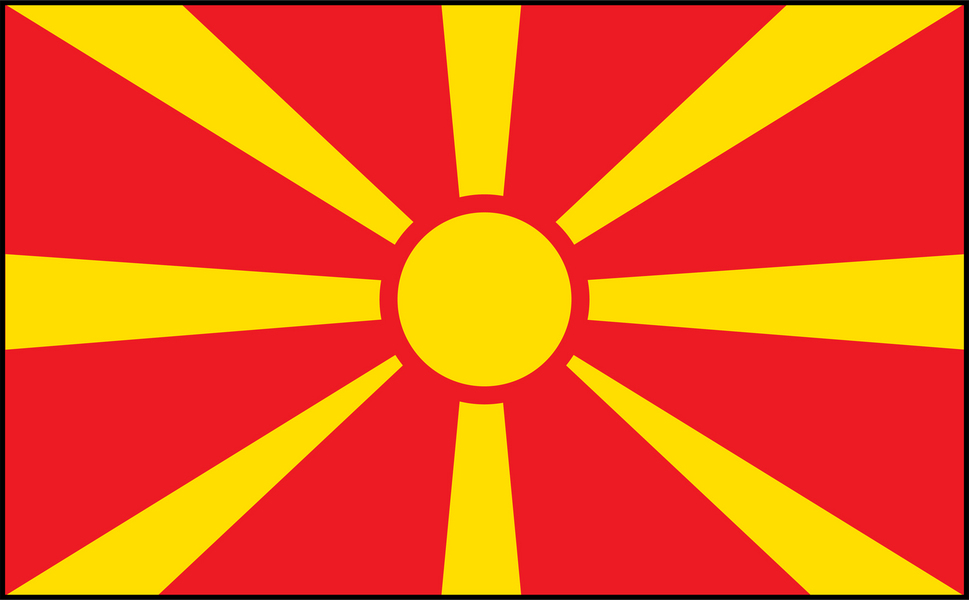Interesting Macedonia Facts
Macedonia is a landlocked country located in South-Eastern Europe where it is bordered by Albania, Bulgaria, Greece, Kosovo and Serbia. It stretches across 25,713 km2 of land. The estimated overall population of Macedonia is over 2,084,338.
Find out interesting Macedonia facts and information about this European country with our fact file for kids. Discover important facts about the geography, landscape, landmarks, flag, population, size, continent, language, people, culture, climate, currency and location of Macedonia.
Identify important information about Europe with our interesting Macedonia facts for kids based on questions such as: What continent is Macedonia in? What is the main language of Macedonia? What is the capital city of Macedonia? What is the population of Macedonia? What is the climate like in Macedonia?
Macedonia Fact File: Continent: Europe * Country Name(s): Macedonia, Republic of Macedonia * Location: South-Eastern Europe * Bordering: Albania, Bulgaria, Greece, Kosovo and Serbia * Capital City: Skopje * Size: 25,713 km2 * Estimated Population: over 2,084,338 * Currency: Macedonian denar (MKD) * Language(s): Macedonian * Country Code: +389
Interesting Macedonia Facts for Kids
Interesting Facts for Kids 1: Size & location facts
Macedonia forms part of the continent of Europe, where it has a landlocked position and is bordered by Albania, Bulgaria, Greece, Kosovo and Serbia. There are seven continents in the world: Asia, Africa, North America, South America, Europe, Antarctica, Australia (Oceania). Europe is the second smallest continent in the world, it has 51 countries, with some countries belonging to both Europe and Asia, spans a total area of 10,180,000 km2 and forms 6.8% of the world's landmass. Macedonia is a landlocked country that encompasses a total area of approximately 25,713 km2. It is one of the smaller countries located on mainland Europe.
Interesting Facts for Kids 2: Population facts
The population of this European country is thought to be more than 2,084,338 people. The majority of Macedonia's inhabitants reside in Skopje which is the country's most populous city. Macedonia has an average population when compared to most other countries across the world, its overall population density is approximately 80 people per sq km. The estimated population of Europe is approximately 738,442,000 inhabitants, making it the continent with the second smallest population in the world. The continents in order of population, starting with highest population first, are: Asia, Africa, North America, South America, Europe, Australia (Oceania Region) and Antarctica. The total population of the entire world is in excess of 7.6 billion people.
Interesting Facts for Kids 3: Capital & major cities
The capital city of Macedonia is Skopje. Other major cities located in this country include Bitola, Kumanovo, Prilep, Tetovo and Čair.
Interesting Facts for Kids 4: Country borders
The following guideline provides details on the approximate border lengths of Macedonia:
Albania 181 km, Bulgaria 162 km, Greece 234 km, Kosovo 160 km, Serbia 101 km.
Interesting Facts for Kids 5: Climate and geography facts
Macedonia experiences dry, warm climatic conditions in the summer and cold, snowy conditions in winter. The geography of Macedonia comprises of mountainous regions, valleys, basins, lakes and rivers. The major lakes of Macedonia are Lake Ohrid, Prespa and Dojran. The largest and longest river of Macedonia is called the Vardar River. The lowest point of Macedonia is the Vardar River at 50m, and the highest point of elevation is Golem Korab at 2,764m.
Interesting Facts for Kids 6: Natural Resources of Macedonia
Natural resources can be defined as materials and substances that occur naturally on Earth. Natural resources are very important across the world, and can be exploited for economic gain. An individual country's natural resources can depend on many factors including the climate, geography and location. Some countries, such as Russia, The United States, Saudi Arabia and Canada, are rich with natural resources, where as others have practically none. Food, construction and transport are three primary examples of uses of natural resources. The following information provides examples of these uses: fish occurs naturally in streams, rivers, lakes and oceans, and can be caught for food consumption. Wood/timber can be extracted from forests for construction purposes, i.e. to build homes and furniture. Crude oils can be refined into different kinds of fuels in order to power vehicles/cars. The natural resources found in Macedonia include low-grade iron ore, copper, zinc, lead, chromite, manganese, nickel, tungsten, silver, gold, asbestos, gypsum, timber, and arable land suitable for growing crops.
Interesting Facts for Kids 7: Language facts
The official language of Macedonia is Macedonian, although approximately one-quarter of the population speak Albanian as a primary language. A small percentage of the population speak other languages as a primary form of communication, such languages include Turkish, Romani and Serbian.
Interesting Facts for Kids 8: Religion facts
The main religion of Macedonia is Macedonian Orthodox at approximately 64% of the population. Around 33% are Muslim. The remaining population either belongs to other religions or no religion at all.
Interesting Facts for Kids 9: Symbols of Macedonia
Every country has its own unique culture, history and identity. Flags, symbols, emblems, mottos, songs, anthems and colors are used by countries across the world to represent national pride and identity. These national symbols are formed through the unique history of a nation and are symbolic of both hardship and prosperity, embodying freedom, strength and unity. Flags, emblems, songs, mottos and colors reflect the past, present and future hopes of a country, and create an important image to the rest of the world. National symbols can include a mixture of things that are symbolic to a country such as animals, birds, flowers, trees, geographical features, tools of agriculture, crops, and tools of war. Here are some important facts on the symbols, songs and colors of Macedonia:
National symbol(s): eight-rayed sun
National colors: red and yellow
National Anthem/Song: Denes nad Makedonija (Translation: Today Over Macedonia)
National Holiday(s): Independence Day, 8 September (1991)
